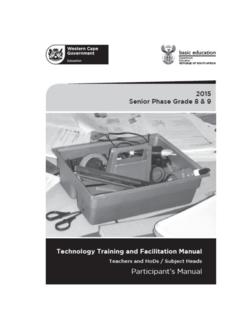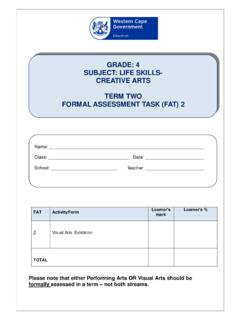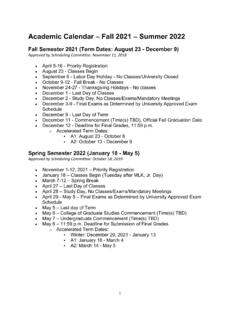Transcription of GRADE: 5 SUBJECT: LIFE SKILLS – CREATIVE ARTS TERM ONE ...
1 grade : 5. SUBJECT: LIFE SKILLS . CREATIVE ARTS. TERM ONE. FORMAL ASSESSMENT TASK (FAT) 1. Name: _____. Class: _____ Date: _____. School: _____ Teacher: _____. Learner's Learner's %. FAT Activity/Form mark Visual Arts: Exhibition TOTAL. LIFE SKILLS : CREATIVE ARTS. FORMAL ASSESSMENT TASK: VISUAL ARTS. grade 5 TERM 1. NOTE TO THE TEACHER: The Formal Assessment Task has been developed as a step by step guideline to learners. The activities are to be done in class, during the first term. It is important that teachers mediate the various steps of the task with learners to ensure active, CREATIVE and critical participation by all learners. ACTIVITY 1: CREATE IN 2D, IMAGES OF SELF AND OTHERS IN. LOCAL ENVIRONMENT, VISUAL LITERACY.. ART MATERIAL: A3 & A2 paper, black wax crayons or koki's, oil pastels or wax crayons, powder paints INSTRUCTIONS: You will be drawing a seated person and a standing one against a local background (for this task it will be your classroom)!
2 In this artwork, you will use the elements of art called LINE, SHAPE and COMPLEMENTARY COLOUR and the design principle called EMPHASIS (FOCAL POINT). It is very important to look really closely at the person's figure, as well as pictures /. photographs of other people (OBSERVATION). You must concentrate hard and look at all the unique aspects of the human figure. GR 5: FAT LS CREATIVE Arts: Visual Arts: Term 1 Page 1. Discuss: With the aid of your teacher explore what you already know of the concepts of drawing and of the human figure. Look at all the different types of figures. Look at the shapes and forms. How is it shaped? Is it more rounded, oval or square? Is it a long body or a short body? Are the legs long or short, etc?
3 Discuss the media with which you will be working. It is important for you to visualise your drawings a painting of a human figure is very different from a line drawing in crayon. Let us first set the scene: Your teacher will seat the one model in an interesting chair and position the standing model next to the seated one so that you have to observe more closely. They will be positioned in an interesting corner / setting in your classroom. The figures should be dressed in clothing that has interesting patterns and one model can even wear an interesting hat. You need to observe and draw from what you see rather than what you know. Discuss the models in detail with one another and your class teacher proportions, the way the clothing falls, different patterns on the clothing, etc.
4 Let us practise first: First trace the lines of the figures in the air. Now, take a black wax crayon and on an A3 piece of paper, begin to draw the models. Try not to take your eyes off the models' figures as you should draw exactly what you see. There is no right or wrong! Just draw what you see! Take your time and draw your lines slowly and carefully. Now let us start the final artwork: Your teacher will now hand out a bigger sheet of paper (A2). You will have to use a viewfinder make your own by cutting out a rectangle from the inside of a small piece of paper. This will help you to position your drawing on paper and use the entire page. You will now draw the seated and standing models again. Your lines should be solid and reflect your view of the models.
5 Make sure that you use most of the page. Be careful not to draw your picture just in a corner of the page. Your drawing must cover the entire page. GR 5: FAT LS CREATIVE Arts: Visual Arts: Term 1 Page 2. Draw the models carefully using lines that are similar to what you see. Try not to take your eyes off them for too long. Remember to include the background as well. Draw the scene / setting in the open spaces of the page, or in the background of the picture. Let's add colour: Your picture is made up of different types of lines at this stage; you may have thick, thin, smooth, jagged, little short lines or long smooth lines. Once the drawings are completed your teacher will discuss the use of colour in your artwork, especially complementary colours.
6 Add colour to your picture. Firstly, mix the colours that you feel would suit your picture best. The paint should be as thick as toothpaste once you have mixed it. Be careful that your brush does not have too much paint on it. Look again at your picture and add your final touches to ensure that you are satisfied with the use of colour and line. When the paint has dried, your teacher will ask you to write your name in the bottom corner of the picture. Your teacher will mount your picture and display it on the wall. Your artwork will be assessed by your teacher who will look at the following aspects of it. GR 5: FAT LS CREATIVE Arts: Visual Arts: Term 1 Page 3. CRITERIA 1-2 3-4 5-6 7-8. Able to, Different types of line have Attempted to Has met the Bold use of but not use different criteria and can different types of been used to depict the types of line, but consistent.
7 Move on to the line to depict the human figure. Needs more not able at all. next level. human figure. practice. Approximatel Three Less than More than 80. y half (40 - quarters (55 - half of the % of the Composition: The page is 55 %) of the 80 %) of the page is page is used fully and the drawing is page is page is covered by covered by well situated covered by covered by the the the the composition composition composition composition Able to mix The paint has The paint has the correct paint, Attempted, but Has met the the correct but not correct consistency. It is suitably not able to mix consistency. criteria to mix consistency and mixed. paint at all. paint suitably. is mixed very Needs more well. practice. Able to apply The paint has The art medium has been well paint , Has met the Inappropriate been applied but not criteria to apply applied.
8 The learner can use application of consistent. paint correctly and it in an appropriate manner. paint. enhances the Needs more appropriately. picture. practice. Attempted to Able to express Has met the Exceeds express him/herself in a criteria to expectations The learner has expressed him/herself, but meaningful express him/her and criteria to him/herself confidently. not able attain manner. confidently and express him/her the desired Needs more in a meaningful confidently. outcome. practice. manner. Subtotals: TOTAL /40. Considering inclusivity: Learners with visual impairment: you could do the same activity using touch to determine the shape and form of the models. Textured material like crayons should be used when drawing.
9 For learners who experience cognitive barriers, break the activity down in smaller, more manageable steps. Ensure that all learners have an opportunity to complete all the steps at their own pace. GR 5: FAT LS CREATIVE Arts: Visual Arts: Term 1 Page 4. ACTIVITY 2: CREATE IN 3D, SELF AND OTHERS IN LOCAL. ENVIRONMENT. ART MATERIAL: Earthenware clay / play dough / Paper M ch . INSTRUCTIONS: You will be sculpting the two figures that you have drawn one seated and one standing! In this artwork, you will use the elements of art called SHAPE / FORM, the design principles called EMPHASIS and PROPORTION, as well as SPATIAL. AWARENESS. It is important to closely observe the two models, as well as pictures / photographs of the human figure in different positions / stances.
10 Pay attention to all the unique aspects of the human figure. Discuss: Look at all the different types of figure. Focus on the shapes and forms of the human figure. Pay attention to detail. Let us first practise: Your teacher will help you with correct preparation of the medium (earthenware clay /. play dough / Paper M ch ). You will be working with your medium on a hard, flat surface. GR 5: FAT LS CREATIVE Arts: Visual Arts: Term 1 Page 5. Your teacher will show you the different techniques that you can use to work with your medium. Start playing with the medium using just your hands. Create shapes / forms to see how the medium can be adapted and changed into different things. Practise making different shapes. Observe the human figures carefully and pay attention to the different features as you practise.









